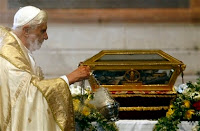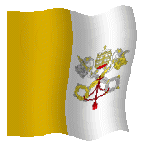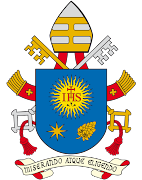Thursday, April 26, 2007
Monday, April 23, 2007
Papal Tombs and Monuments 1655-1799 (Part V)
 Pope Alexander VIII died on 1 February 1691 in Rome. He was buried on 5 February in the Patriarchal Vatican Basilica, and his mortal remains were transferred on 18 February 1706 within the same basilica.
Pope Alexander VIII died on 1 February 1691 in Rome. He was buried on 5 February in the Patriarchal Vatican Basilica, and his mortal remains were transferred on 18 February 1706 within the same basilica. Caption Competition
Saturday, April 21, 2007
Papal Tombs and Monuments 1655-1799 (Part IV)


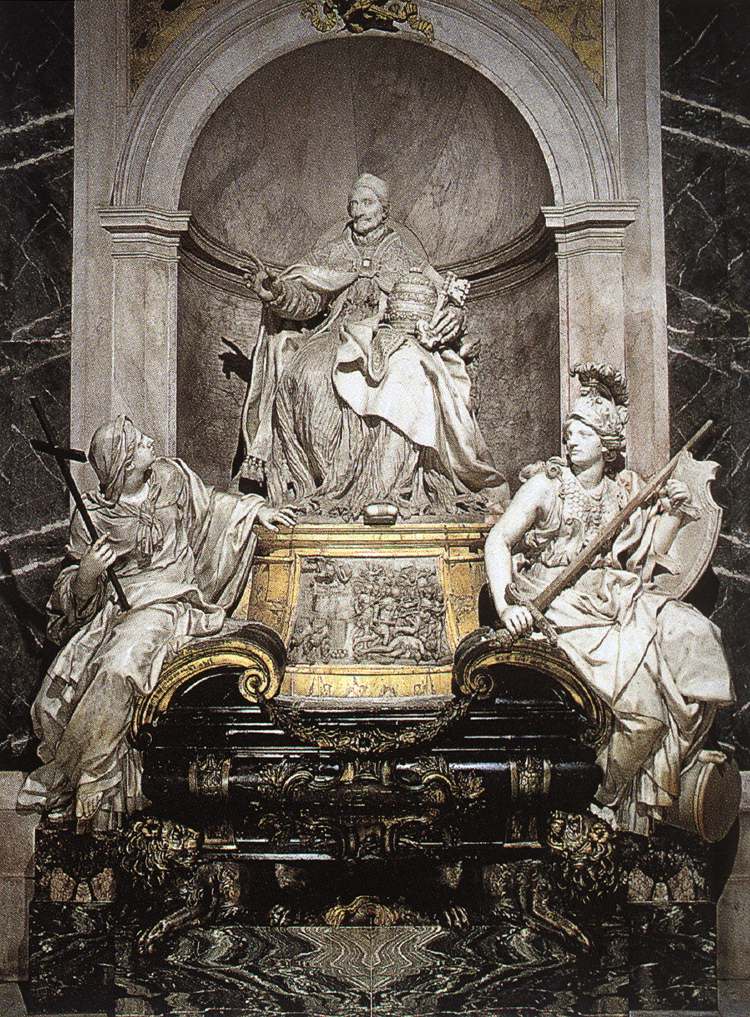 Pope Innocent XI died on 12 August 1689 in Rome. He was buried on 16 August in the Patriarchal Vatican Basilica, and his mortal remains were transferred on 26 July 1701 to the Grottoes of the same basilica. The diocesan process for his canonization was initiated on 11 April 1691, his heroic virtues were proclaimed on 15 November 1955 by Pope Pius XII, and he was beatified on 7 October 1956 by the same Roman Pontiff. His mortal remains were afterwards transferred to the altar of the Chapel of St. Sebastian of the Patriarchal Vatican Basilica.
Pope Innocent XI died on 12 August 1689 in Rome. He was buried on 16 August in the Patriarchal Vatican Basilica, and his mortal remains were transferred on 26 July 1701 to the Grottoes of the same basilica. The diocesan process for his canonization was initiated on 11 April 1691, his heroic virtues were proclaimed on 15 November 1955 by Pope Pius XII, and he was beatified on 7 October 1956 by the same Roman Pontiff. His mortal remains were afterwards transferred to the altar of the Chapel of St. Sebastian of the Patriarchal Vatican Basilica.

Papal Tombs and Monuments 1655-1799 (Part III)

 His Eminence Emilio Bonaventura Cardinal Altieri, Cardinal Priest, former Bishop of Camerino, Prefect of the Cubiculi of His Holiness. Elected Bishop of Rome on 29 April 1670 in the Vatican Apostolic Palace, taking the name Clement X.
His Eminence Emilio Bonaventura Cardinal Altieri, Cardinal Priest, former Bishop of Camerino, Prefect of the Cubiculi of His Holiness. Elected Bishop of Rome on 29 April 1670 in the Vatican Apostolic Palace, taking the name Clement X.  Pope Clement X died on 22 July 1676 in Rome, in the 7th year of his pontificate. He was buried on 26 July in the Patriarchal Vatican Basilica, and his mortal remains were transferred on 15 October 1691 to the Chapel of St. Petronilla of the same basilica.
Pope Clement X died on 22 July 1676 in Rome, in the 7th year of his pontificate. He was buried on 26 July in the Patriarchal Vatican Basilica, and his mortal remains were transferred on 15 October 1691 to the Chapel of St. Petronilla of the same basilica.
Thursday, April 19, 2007
19th April 2005
 Annuntio vobis gaudium magnum; habemus Papam:
Annuntio vobis gaudium magnum; habemus Papam:Eminentissimum ac Reverendissimum Dominum, Dominum Josephum Sanctae Romanae Ecclesiae Cardinalem Ratzinger qui sibi nomen imposuit Benedictum XVI
 Dear Brothers and Sisters,
Dear Brothers and Sisters,After the great Pope John Paul II, the Cardinals have elected me, a simple and humble labourer in the vineyard of the Lord.
The fact that the Lord knows how to work and to act even with inadequate instruments comforts me, and above all I entrust myself to your prayers.
Let us move forward in the joy of the Risen Lord, confident of his unfailing help. The Lord will help us and Mary, his Most Holy Mother, will be on our side.
Sunday, April 15, 2007
Ad multos annos
 Birth
BirthApril 16, 1927, Holy Saturday, at 4:15 a.m., Marktl, diocese of Passau, Germany. He was baptized with the name Joseph Alois on that same day at 8: 30 a.m., in the parish of Saint Oswald in Marktl, by Fr. Josef Stangl, vicar of Marktl. He received first communion in March 1936 and the sacrament of confirmation on June 9, 1937 in Traunstein from Cardinal Michael von Faulhaber, archbishop of München und Freising.
Education
Superior School of Philosophy, Freising; University of München, München (doctorate in theology; thesis: "People and house of God in the doctrine on the church of St. Augustin"). Received the subdiaconate, Saturday October 28, 1950, Freising, from Johannes Baptist Neuhäusler, titular bishop of Calidone, auxiliary of München und Freising; and the diaconate the following day in the same place and from the same bishop.
Priesthood
Ordained, June 29, 1951, cathedral of Sts. Mary and Corbinian, Freising, by Cardinal Michael von Faulhaber, archbishop of München und Freising. Further studies, 1951-1952. Faculty member at the Superior School of Philosophy and Theology, Freising, 1952-1959. Faculty member at the University of Bonn, 1959-1963. Participated in the Second Vatican Council, 1962-1965, as an expert. Faculty member at the University of Münster, 1963-1969. Faculty member at the University of Tübingen, 1966-1969. Faculty member at the University of Ratisbon, 1969-1977; its vice-president, 1969-1977.Member of the International Theological Commission, Vatican City, 1969-1977.
Episcopate
Elected archbishop of München und Freising, March 24, 1977. Consecrated, May 28, 1977, cathedral of München, by Josef Stangl, bishop of Würzburg, assisted by Rudolf Graber, bishop of Regensburg, and by Ernst Tewes, C.O., titular bishop of Villamagna in Proconsulari, auxiliary of München und Freising.
Cardinalate
Created cardinal priest in the consistory of June 27, 1977; received the red biretta and the title of S. Maria Consolatrice al Tiburtino, June 27, 1977. Prefect of the S.C. for the Doctrine of the Faith, president of the Pontifical Biblical Commission, and president of the International Theological Commission, November 25, 1981 to April 2, 2005. Resigned the pastoral government of the archdiocese, February 15, 1982. Named bishop of title of suburbicarian see of Velletri-Segni, April 5, 1993. Vice-dean of College of Cardinals, November 9, 1998. Dean of the College of Cardinals and bishop of the title of the suburbicarian see of Ostia, proper of the dean, retaining the title of the suburbicarian see of Velletri-Segni, November 30, 2002. Participated in the conclave of April 18 to 19, 2005 and was elected pope.
Papacy
Elected pope on April 19, 2005; took the name Benedict XVI. The ceremony to mark the beginning of his pontificate took place on April 24, 2005.
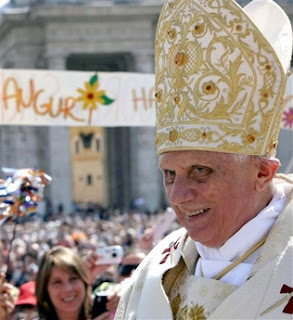 Biographical information adapted from The Cardinals of the Holy Roman Church
Biographical information adapted from The Cardinals of the Holy Roman Church
Papal Tombs and Monuments 1655-1799 (Part II)


Pope Clement IX died on 9 December 1669 in Rome. He was buried on 12 December under the pavement of the patriarchal Liberian basilica (St Mary Major) with a simple epitaph: Clementis IX, Cineres. His successor, Pope Clement X, erected an elegant monument in his memory at the right side of the nave of that basilica, near the door.
Update on Yad Vashem row
Saturday, April 14, 2007
Papal Tombs and Monuments 1655-1799 (Part I)

 His Eminence Fabio Cardinal Chigi, Cardinal Priest of Santa Maria del Popolo, Bishop of Imola, Secretary of State. Elected Bishop of Rome on 7 April 1655 in the Vatican Apostolic Palace, taking the name Alexander VII.
His Eminence Fabio Cardinal Chigi, Cardinal Priest of Santa Maria del Popolo, Bishop of Imola, Secretary of State. Elected Bishop of Rome on 7 April 1655 in the Vatican Apostolic Palace, taking the name Alexander VII.  Alexander VII's funeral monument is the last great masterpiece of the 80-year old Gian Lorenzo Bernini (assisted by various artists). The Pontiff, kneeling and absorbed in prayer, is not disturbed by the sudden appearance of Death, who, raising a heavy pall, brandishes an hour-glass to indicate that time has passed.
Alexander VII's funeral monument is the last great masterpiece of the 80-year old Gian Lorenzo Bernini (assisted by various artists). The Pontiff, kneeling and absorbed in prayer, is not disturbed by the sudden appearance of Death, who, raising a heavy pall, brandishes an hour-glass to indicate that time has passed. Friday, April 13, 2007
New English translation of the Mass
Click here to read it.
Thursday, April 12, 2007
Mit Brennender Sorge at 70
 As highlighted by the St Mary Magdalene Blog of Fr Ray Blake, the 70th anniversary of Pius XI’s condemnation of Nazism, Mit Brennender Sorge, passed recently. While Fr Blake provides us with a detailed exegesis of the encyclical, his analysis is rather hagiographical. This posting attempts to place the encyclical in a (critical) historical perspective.
As highlighted by the St Mary Magdalene Blog of Fr Ray Blake, the 70th anniversary of Pius XI’s condemnation of Nazism, Mit Brennender Sorge, passed recently. While Fr Blake provides us with a detailed exegesis of the encyclical, his analysis is rather hagiographical. This posting attempts to place the encyclical in a (critical) historical perspective.Firstly it should be acknowledged that Mit Brennender Sorge is an impressive document and should be remembered - along with Non Abbiamo Bisogno - as a condemnation issued by a high-profile world leader at a time when many others were still treating with both the Fascists and the Nazis.
Therein, however, lies the problem. Before he condemned both regimes - and historical rumour tells us that Pius was preparing a stinging condemnation of Mussolini at the time of his death in February 1939 - Pius had worked rather too closely with both.
In the early 1920s Pius categorised Benito Mussolini as 'a man whom providence has sent'. The eventual fruits of their understanding was the 1929 Lateran Treaties which finally solved the 59 year old Roman Question. However, in aligning himself with Mussolini, Pius accepted - among other things - the political emasculation of the Italian Catholic Party - the Popolari - led by Don Luigi Sturzo.
So, what was Achille Ratti up to? Quite simply he saw the real enemy as Communism and was prepared to buy into the concept that ‘the enemy of my enemy is my friend’.
Holocaust Memorial Dispute
Read the full article here.
Wednesday, April 11, 2007
Where in the world?
Portugal - Lisboa
Romania - Craiova, Dolj
United States - Hayward, California
France - Gentilly, Ile-de-France
United States - Saint Louis, Missouri
Unknown Country - ???
United States - Winston Salem, North Carolina
Guatemala - El Salvador, Huehuetenango
Belgium - Bredene, West-Vlaanderen
Belgium - Oosterzele, Oost-Vlaanderen
Brazil - Florianpolis, Santa Catarina
Belgium - Bruxelles, Brussels Hoofdstedelijk Gewest
Spain - Murcia
Discerning the terna (again)
Tuesday, April 10, 2007
Where in the world?
United States - Cleveland, Ohio
Belgium - Lille, Antwerpen
United States - Needham Heights, Massachusetts
United Kingdom - Cardiff
Germany - Kassel, Hessen
Trinidad and Tobago - Chaguanas, Caroni
United States - Providence, Rhode Island
United Kingdom - Belvedere, Bexley
United Kingdom - Monymusk, Aberdeenshire
Indonesia - Jakarta, Jawa Barat
United States - Fairfield, Connecticut
Careless Whispers!
 The great Rocco Palmo - of Whispers in the Loggia fame - doesn't often get things wrong, however I notice a slight error in his most recent posting where he states (among other things) that
The great Rocco Palmo - of Whispers in the Loggia fame - doesn't often get things wrong, however I notice a slight error in his most recent posting where he states (among other things) thatBenedict XVI also named the retired and superannuated Cardinal Jorge Arturo Medina Estevez as a voting delegate (at the forthcoming Plenary of the Latin American bishops). The choice of the controversial Chilean, formerly prefect of the Congregation for Divine Worship and still protodeacon of the college of cardinals.
 lace on February 23, 2007, Pope Benedict XVI confirmed Cardinal Darío Castrillón Hoyos, (above, left) deacon of SS. Nome di Maria al Foro Traiano, prefect emeritus of the Congregation for the Clergy and president of the Pontifical Commission Ecclesia Dei, as cardinal protodeacon, succeeding Cardinal Jorge Arturo Medina Estévez, (above, right - announcing the election of Benedict XVI when he attempted to address all his 'brothers and sisters' in the crowd in about a zillion languages) deacon of S. Saba, prefect emeritus of the Congregation for Divine Worship and the Discipline of the Sacraments, who had been protodeacon since February 24, 2005.
lace on February 23, 2007, Pope Benedict XVI confirmed Cardinal Darío Castrillón Hoyos, (above, left) deacon of SS. Nome di Maria al Foro Traiano, prefect emeritus of the Congregation for the Clergy and president of the Pontifical Commission Ecclesia Dei, as cardinal protodeacon, succeeding Cardinal Jorge Arturo Medina Estévez, (above, right - announcing the election of Benedict XVI when he attempted to address all his 'brothers and sisters' in the crowd in about a zillion languages) deacon of S. Saba, prefect emeritus of the Congregation for Divine Worship and the Discipline of the Sacraments, who had been protodeacon since February 24, 2005. Monday, April 09, 2007
How (some) others see us
Click here to read what he has written.
Sunday, April 08, 2007
Christus Resurrexit

EASTER 2007
Dear Brothers and Sisters throughout the world,Men and women of good will!
Christ is risen! Peace to you! Today we celebrate the great mystery, the foundation of Christian faith and hope: Jesus of Nazareth, the Crucified One, has risen from the dead on the third day according to the Scriptures. We listen today with renewed emotion to the announcement proclaimed by the angels on the dawn of the first day after the Sabbath, to Mary of Magdala and to the women at the sepulchre: “Why do you search among the dead for one who is alive? He is not here, he is risen!” (Lk 24:5-6).
It is not difficult to imagine the feelings of these women at that moment: feelings of sadness and dismay at the death of their Lord, feelings of disbelief and amazement before a fact too astonishing to be true. But the tomb was open and empty: the body was no longer there. Peter and John, having been informed of this by the women, ran to the sepulchre and found that they were right. The faith of the Apostles in Jesus, the expected Messiah, had been submitted to a severe trial by the scandal of the cross. At his arrest, his condemnation and death, they were dispersed. Now they are together again, perplexed and bewildered. But the Risen One himself comes in response to their thirst for greater certainty. This encounter was not a dream or an illusion or a subjective imagination; it was a real experience, even if unexpected, and all the more striking for that reason. “Jesus came and stood among them and said to them, ‘peace be with you!’” (Jn 20:19).
At these words their faith, which was almost spent within them, was re-kindled. The Apostles told Thomas who had been absent from that first extraordinary encounter: Yes, the Lord has fulfilled all that he foretold; he is truly risen and we have seen and touched him! Thomas however remained doubtful and perplexed. When Jesus came for a second time, eight days later in the Upper Room, he said to him: “put your finger here and see my hands; and put out your hand and place it in my side; do not be faithless, but believing!” The Apostle’s response is a moving profession of faith: “My Lord and my God!” (Jn 20:27-28).
“My Lord and my God!” We too renew that profession of faith of Thomas. I have chosen these words for my Easter greetings this year, because humanity today expects from Christians a renewed witness to the resurrection of Christ; it needs to encounter him and to know him as true God and true man. If we can recognize in this Apostle the doubts and uncertainties of so many Christians today, the fears and disappointments of many of our contemporaries, with him we can also rediscover with renewed conviction, faith in Christ dead and risen for us. This faith, handed down through the centuries by the successors of the Apostles, continues on because the Risen Lord dies no more. He lives in the Church and guides it firmly towards the fulfilment of his eternal design of salvation.
We may all be tempted by the disbelief of Thomas. Suffering, evil, injustice, death, especially when it strikes the innocent such as children who are victims of war and terrorism, of sickness and hunger, does not all of this put our faith to the test? Paradoxically the disbelief of Thomas is most valuable to us in these cases because it helps to purify all false concepts of God and leads us to discover his true face: the face of a God who, in Christ, has taken upon himself the wounds of injured humanity. Thomas has received from the Lord, and has in turn transmitted to the Church, the gift of a faith put to the test by the passion and death of Jesus and confirmed by meeting him risen. His faith was almost dead but was born again thanks to his touching the wounds of Christ, those wounds that the Risen One did not hide but showed, and continues to point out to us in the trials and sufferings of every human being.
“By his wounds you have been healed” (1 Pt 2:24). This is the message Peter addressed to the early converts. Those wounds that, in the beginning were an obstacle for Thomas’s faith, being a sign of Jesus’ apparent failure, those same wounds have become in his encounter with the Risen One, signs of a victorious love. These wounds that Christ has received for love of us help us to understand who God is and to repeat: “My Lord and my God!” Only a God who loves us to the extent of taking upon himself our wounds and our pain, especially innocent suffering, is worthy of faith.
How many wounds, how much suffering there is in the world! Natural calamities and human tragedies that cause innumerable victims and enormous material destruction are not lacking. My thoughts go to recent events in Madagascar, in the Solomon Islands, in Latin America and in other regions of the world. I am thinking of the scourge of hunger, of incurable diseases, of terrorism and kidnapping of people, of the thousand faces of violence which some people attempt to justify in the name of religion, of contempt for life, of the violation of human rights and the exploitation of persons. I look with apprehension at the conditions prevailing in several regions of Africa. In Darfur and in the neighbouring countries there is a catastrophic, and sadly to say underestimated, humanitarian situation. In Kinshasa in the Democratic Republic of the Congo the violence and looting of the past weeks raises fears for the future of the Congolese democratic process and the reconstruction of the country. In Somalia the renewed fighting has driven away the prospect of peace and worsened a regional crisis, especially with regard to the displacement of populations and the traffic of arms. Zimbabwe is in the grip of a grievous crisis and for this reason the Bishops of that country in a recent document indicated prayer and a shared commitment for the common good as the only way forward.
Likewise the population of East Timor stands in need of reconciliation and peace as it prepares to hold important elections. Elsewhere too, peace is sorely needed: in Sri Lanka only a negotiated solution can put an end to the conflict that causes so much bloodshed; Afghanistan is marked by growing unrest and instability; In the Middle East, besides some signs of hope in the dialogue between Israel and the Palestinian authority, nothing positive comes from Iraq, torn apart by continual slaughter as the civil population flees. In Lebanon the paralysis of the country’s political institutions threatens the role that the country is called to play in the Middle East and puts its future seriously in jeopardy. Finally, I cannot forget the difficulties faced daily by the Christian communities and the exodus of Christians from that blessed Land which is the cradle of our faith. I affectionately renew to these populations the expression of my spiritual closeness.
Dear Brothers and sisters, through the wounds of the Risen Christ we can see the evils which afflict humanity with the eyes of hope. In fact, by his rising the Lord has not taken away suffering and evil from the world but has vanquished them at their roots by the superabundance of his grace. He has countered the arrogance of evil with the supremacy of his love. He has left us the love that does not fear death, as the way to peace and joy. “Even as I have loved you – he said to his disciples before his death – so you must also love one another” (cf. Jn 13:34).
Brothers and sisters in faith, who are listening to me from every part of the world! Christ is risen and he is alive among us. It is he who is the hope of a better future. As we say with Thomas: “My Lord and my God!”, may we hear again in our hearts the beautiful yet demanding words of the Lord: “If any one serves me, he must follow me; and where I am, there shall my servant be also; if any one serves me, the Father will honour him” (Jn 12:26). United to him and ready to offer our lives for our brothers (cf. 1 Jn 3:16), let us become apostles of peace, messengers of a joy that does not fear pain – the joy of the Resurrection. May Mary, Mother of the Risen Christ, obtain for us this Easter gift. Happy Easter to you all.


